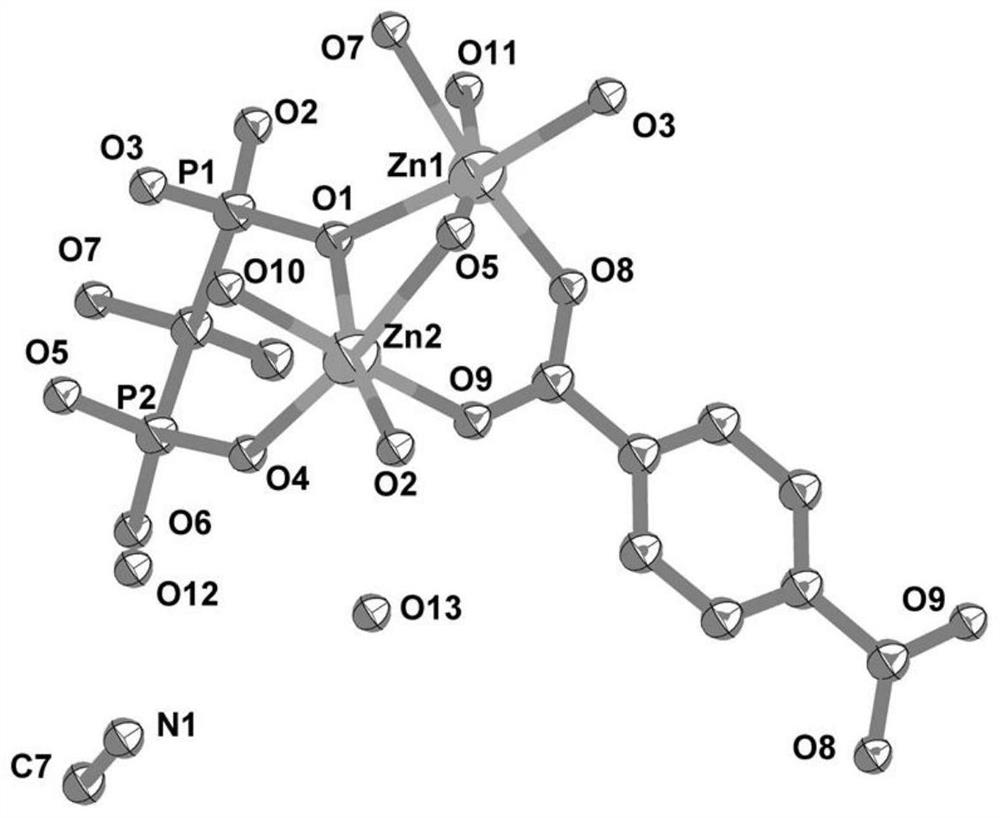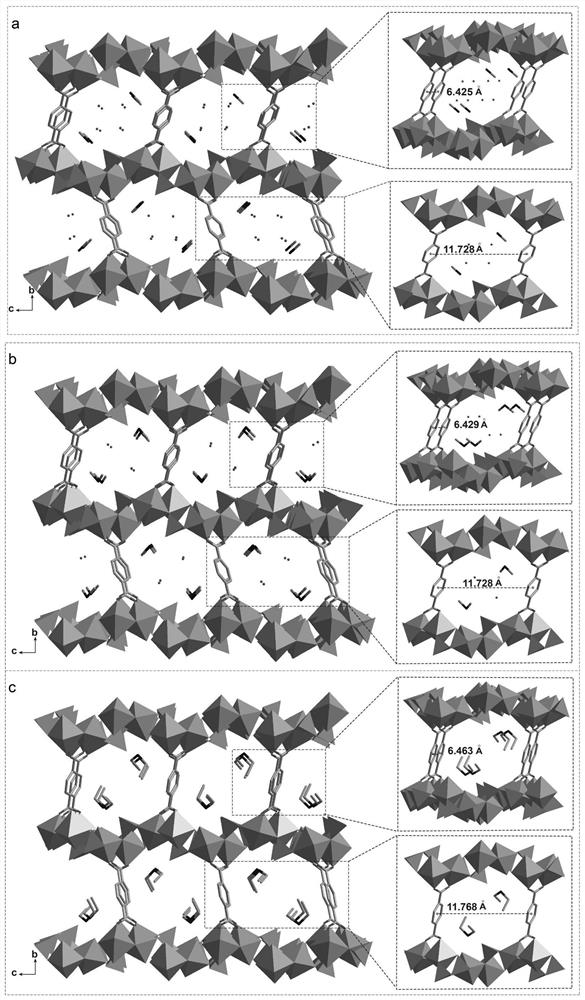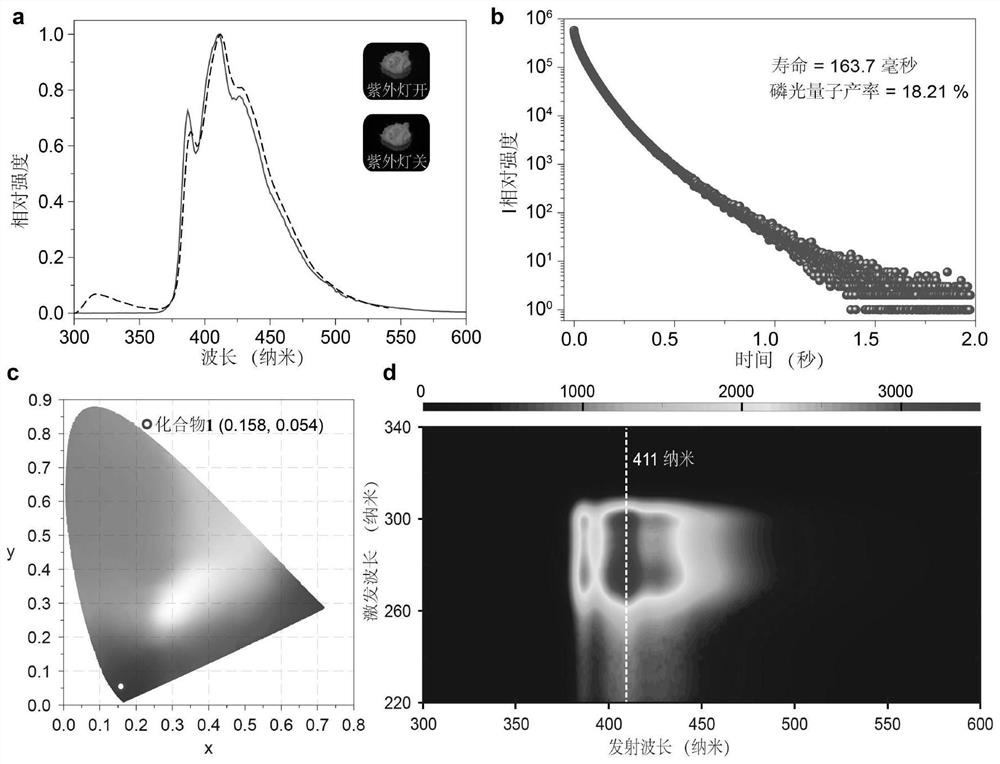Novel efficient blue room-temperature phosphorescent material and preparation method thereof
A room temperature phosphorescence, a new type of technology, applied in the direction of luminescent materials, organic chemical methods, chemical instruments and methods, etc., can solve the problems of short distance, difficulty of blue hybrid RTP materials, etc. simple effect
- Summary
- Abstract
- Description
- Claims
- Application Information
AI Technical Summary
Problems solved by technology
Method used
Image
Examples
Embodiment 1
[0029] In this example, zinc oxide (0.080~0.166g, 1~2mmol) and terephthalic acid (0.080~0.166g, 1~2mmol) were added to a 20mL polytetrafluoroethylene-lined stainless steel reaction kettle, and 10mL of water and formaldehyde Dissolve the mixed solution of amine (0.7~0.9mL), add hydroxyethylidene diphosphonic acid monohydrate (0.11~0.22g, 0.5~1mmol) and hydrofluoric acid (0.2mL) while stirring, after fully stirring, put the Seal the stainless steel reaction kettle with the reaction solution, and crystallize it in an oven at 80°C for 6-7 days. After the reaction is completed, take out the stainless steel reaction kettle and let it cool naturally at room temperature, remove the crystals generated in the stainless steel reaction kettle and wash it with deionized water Washing was repeated 5 times, and drying at room temperature gave colorless flaky crystals, which were designated as compound 1.
[0030] In this example, the prepared compound 1 was subjected to single crystal diffra...
Embodiment 2
[0032] In this example, zinc oxide (0.080~0.166g, 1~2mmol) and terephthalic acid (0.080~0.166g, 1~2mmol) were added to a 20mL polytetrafluoroethylene-lined stainless steel reaction kettle, and 5mL water and 5mL The mixed solution of N,N-dimethylformamide (1:1) was dissolved, and hydroxyethylidene diphosphonic acid monohydrate (0.11~0.22g, 0.5~1mmol) and hydrofluoric acid (0.2mL) were added while stirring , after fully stirring, seal the stainless steel reactor containing the reaction solution, and crystallize in an oven at 145° C. for 6-7 days. After the reaction is completed, the method of cooling, washing and drying as in Example 1 is obtained to obtain compound 2 , the various characterizations of the target product obtained are the same as in Example 1.
[0033] In this example, compound 2 was subjected to single crystal diffraction, and the data analysis showed that compound 2 is isomorphic with compound 1, and has a columnar layer structure, and protonated dimethylamine ...
Embodiment 3
[0035] In this example, zinc oxide (0.080~0.166g, 1~2mmol), and terephthalic acid (0.080~0.166g, 1~2mmol) were added to a 20mL polytetrafluoroethylene-lined stainless steel reaction kettle, and 5mL of water and 5mL N,N-diethylformamide mixed solution (1:1) was dissolved, and hydroxyethylidene diphosphonic acid monohydrate (0.11~0.3g, 0.5~1.5mmol) and hydrofluoric acid (0.2mL ), after fully stirring, the stainless steel reaction kettle with the reaction solution was sealed, crystallized in an oven at 145°C for 6-7 days, after the reaction was completed, the compound was obtained by cooling, washing and drying as in Example 1 3. The characteristics of the obtained target product are the same as in Example 1.
[0036] This embodiment carries out single crystal diffraction to compound 2 and 3, and its data analysis shows that compound 3 is isomorphic with compound 1, has column layer structure, and protonated dimethylamine and diethylamine are filled in interlayer as guest ( fig...
PUM
 Login to View More
Login to View More Abstract
Description
Claims
Application Information
 Login to View More
Login to View More - R&D
- Intellectual Property
- Life Sciences
- Materials
- Tech Scout
- Unparalleled Data Quality
- Higher Quality Content
- 60% Fewer Hallucinations
Browse by: Latest US Patents, China's latest patents, Technical Efficacy Thesaurus, Application Domain, Technology Topic, Popular Technical Reports.
© 2025 PatSnap. All rights reserved.Legal|Privacy policy|Modern Slavery Act Transparency Statement|Sitemap|About US| Contact US: help@patsnap.com



